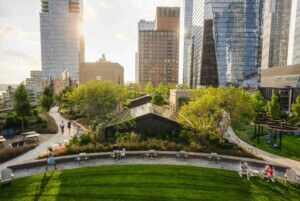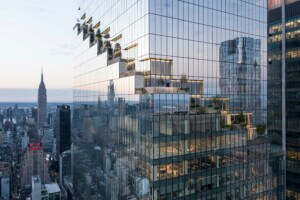It isn’t often that one has the chance to perform in a world premiere. I’ve performed in a few during my forty years as an avocational singer, but never anything like the Mile Long Opera (MLO), which ran in New York City from October 2 to 8, 2018.
Because I am also an architect, performing as a singer and actor in the MLO was a special privilege. I was able to see both the dramatic material and the urbanistic setting from an insider’s point of view. I am convinced that David Lang, Liz Diller, Claudia Rankine, Anne Carson, and the producers of MLO created a modern masterpiece.
With the rather enigmatic subtitle, “A Biography of Seven O’Clock,” the MLO’s hype suggested that audience members would get a taste, maybe a big gulp, of what makes New York City so extraordinary, and also so ordinary. The first surprise was that they delivered on that promise.
By using choirs from throughout the city’s five boroughs, some professional and/or small, others amateur and/or large, the creative team assembled a cast that resonated with just about everyone. Sprinkling some professional opera singers among the throng of ordinary folks provided just enough weight to please the likes of Renée Fleming, who attended a performance in mid-week, and other cognoscenti.
It would have been easy to lose the multi-ethnic and multi-cultural flavor of so many New York singers strung single file along a narrow, mile-and-a-half walkway, especially in the evening hours under varied lighting conditions. Here, the production designers earned their stripes by developing several masterful costume and lighting conceits. The most effective was the duck-like baseball cap worn by the majority of us, which bathed the face in a soft, ethereal aurora. Audience members described the effect of the floating faces as dreamlike—we were instructed to wear only dark so our faces would stand out.
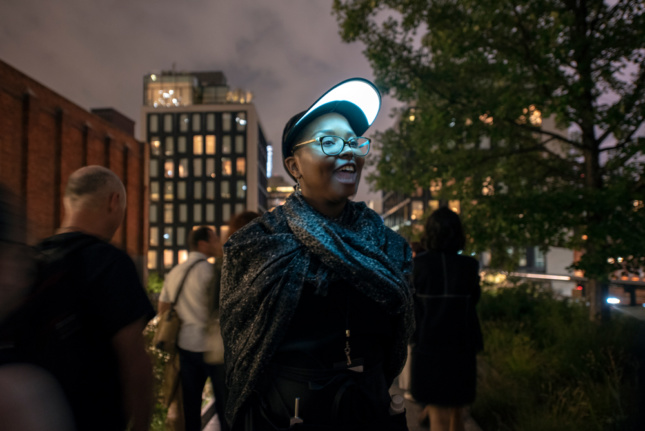
By lighting the faces of each performer, MLO designers brought both the wonderful variety and the individuality of New York’s inhabitants into focus on the High Line. As the audience walked by, each singer or speaker could touch passing strangers with a look or an expression, while also declaiming their portions of the libretto (some of it in Spanish). I can say that for me, those brief glances from listeners were unforgettable. I thought of the paintings on the wall of a museum gazing out at amazed art lovers—Magritte would be jealous.
Was there music in this opera? Yes and no. David Lang, of Bang on a Can fame, has explored sound in just about every possible way during a long career. Thus one would hardly have expected a conventional piece of musical theater, and indeed those of us singing and speaking our parts were initially rather confused by what we heard. There were no chords, no apparent melody, no key signatures, and apparently no “leitmotifs” to provide a map of the work. Even the first rehearsals were puzzling—where would we stand in relation to our fellow choir members? Was there an alto or bass part? All we knew was that this was a piece for voices and that we would be singing without amplification.
There were big risks involved in putting singers of varying abilities out in the midst of a bustling urban environment. How could anyone but an operatic diva be heard above the street noise? When I looked at the first robot camera footage of the “cells” (individual areas with specific parts of the libretto and music) that were posted by the sponsor, Target, I was concerned that many voices were not coming through the texture. After performing for a couple of nights I realized what I had missed, and why our composer had written such unusual “music.”
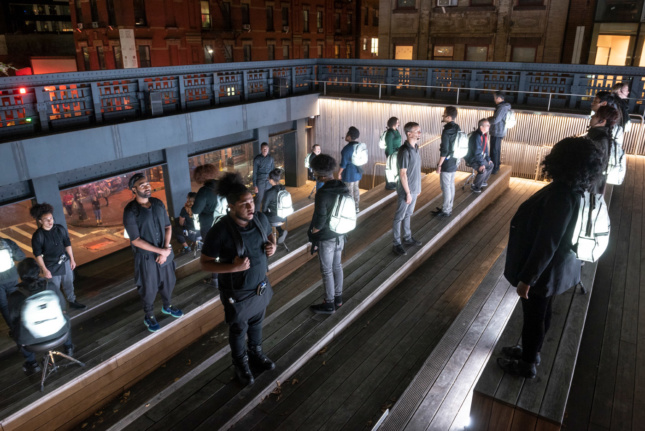
This was an immersive experience. Even more important than seeing the piece on the High Line was listening to every voice along the way. Lang gave the audience an active part in the drama as it unfolded before them. You really had to “lean in” to get the full intellectual and sensory power of the narrative. By lighting the faces of each performer, or group of performers, Lang and his collaborators invited the audience to parse the threads of text, sound, and light, both momentary and temporally continuous. The music and libretto established a repeating theme, marked by phrases and distinctive vocal riffs, that would eventually make sense in the context of a moving, walking perceptual gestalt.
There was, first of all, the recurrence of the dining table in the spoken narrative. I did not realize how my version of this little “recollection” would strike audience members as they heard me say “Between us, I love my dining room table.” With a common memory, shared by so many of us, Claudia Rankine established an immediate frame of reference.
In the music, themes of community, loss, loneliness, love, and deprivation played out in vignettes sung by recognizable characters from the city: a Vietnamese nail salon technician, a construction worker, an eight-year-old walking with his aunt, lovers at the movies, a hotel maid, a window washer. One thousand voices, each distinct, would finally create a “cloud” of meaning, at least in theory.
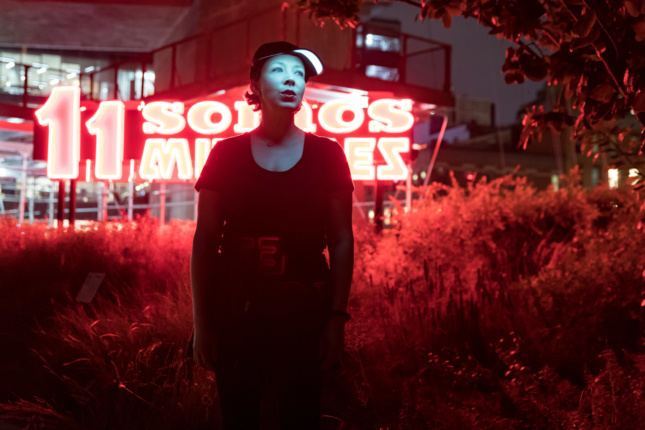
Before each performance, we heard our directors describe the “miracle” that was occurring each night. Press notices were positive, but it was the audience that gave us the best feedback on the piece. They were spellbound, amazed, and entirely engaged. Friends invariably would ask if tickets were available—they had heard the hype. Alas, anyone who failed to get a pass would miss one of the cultural events of the new century. I thought of how pissed I was to have missed Einstein On The Beach. It was like you had to see MLO in order to be a hip New Yorker in 2018, at least among choral geeks.
For architects, the allure was just as strong. The tapestry sound would not have been so striking without the incredible setting of the High Line. One should always mention James Corner and the community activists who fought to save the elevated tracks from Gansevoort to 34th Street, because this was adaptive re-use at its best. Architect Liz Diller and her staff saw the potential of the linear park as a performance space and helped to design the enhancements to the setting that made the piece ring so beautifully, in a visual sense. Indeed, it was the synesthetic character of the Mile Long Opera that I believe signaled its importance as a new kind of performance piece.
The Mile Long Opera was an intense distillation of the things that make New York the greatest city in the world. It brought us the city of the imagination, the city of technology, the city of skyscrapers, the city of world theater, the city of music, the city of strangers, the city of magic, the city of poverty, the city of transport, the city of wealth, and above all the place that we call New York. At the end of the performance, Anne Carson’s poetry captured everything in a few trenchant, Whitmanesque lines: “Whatever can happen in a city can happen in this city, whatever can happen to anyone can happen to us. Onward rolls the bright current.”








